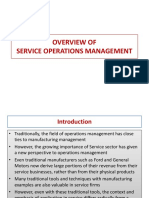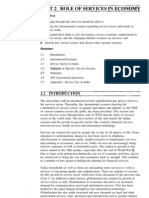0% found this document useful (0 votes)
82 views13 pagesLecture - 1: Introduction and Imperatives of Services
The document discusses the importance and role of services in modern economies. It notes that services now account for over half of India's GDP and around a third of employment. Key points made include:
- Services are intangible activities that are consumed at the time of production and include sectors like trade, transportation, finance, IT and government.
- Services have become essential to daily life and have allowed more women to join the workforce. Manufacturing companies also increasingly rely on accompanying services.
- The Indian services sector has grown significantly and includes fast growing industries like IT, telecom, finance, and hospitality that have supported the overall economy.
Uploaded by
RiazCopyright
© © All Rights Reserved
We take content rights seriously. If you suspect this is your content, claim it here.
Available Formats
Download as DOCX, PDF, TXT or read online on Scribd
0% found this document useful (0 votes)
82 views13 pagesLecture - 1: Introduction and Imperatives of Services
The document discusses the importance and role of services in modern economies. It notes that services now account for over half of India's GDP and around a third of employment. Key points made include:
- Services are intangible activities that are consumed at the time of production and include sectors like trade, transportation, finance, IT and government.
- Services have become essential to daily life and have allowed more women to join the workforce. Manufacturing companies also increasingly rely on accompanying services.
- The Indian services sector has grown significantly and includes fast growing industries like IT, telecom, finance, and hospitality that have supported the overall economy.
Uploaded by
RiazCopyright
© © All Rights Reserved
We take content rights seriously. If you suspect this is your content, claim it here.
Available Formats
Download as DOCX, PDF, TXT or read online on Scribd
/ 13















































































































